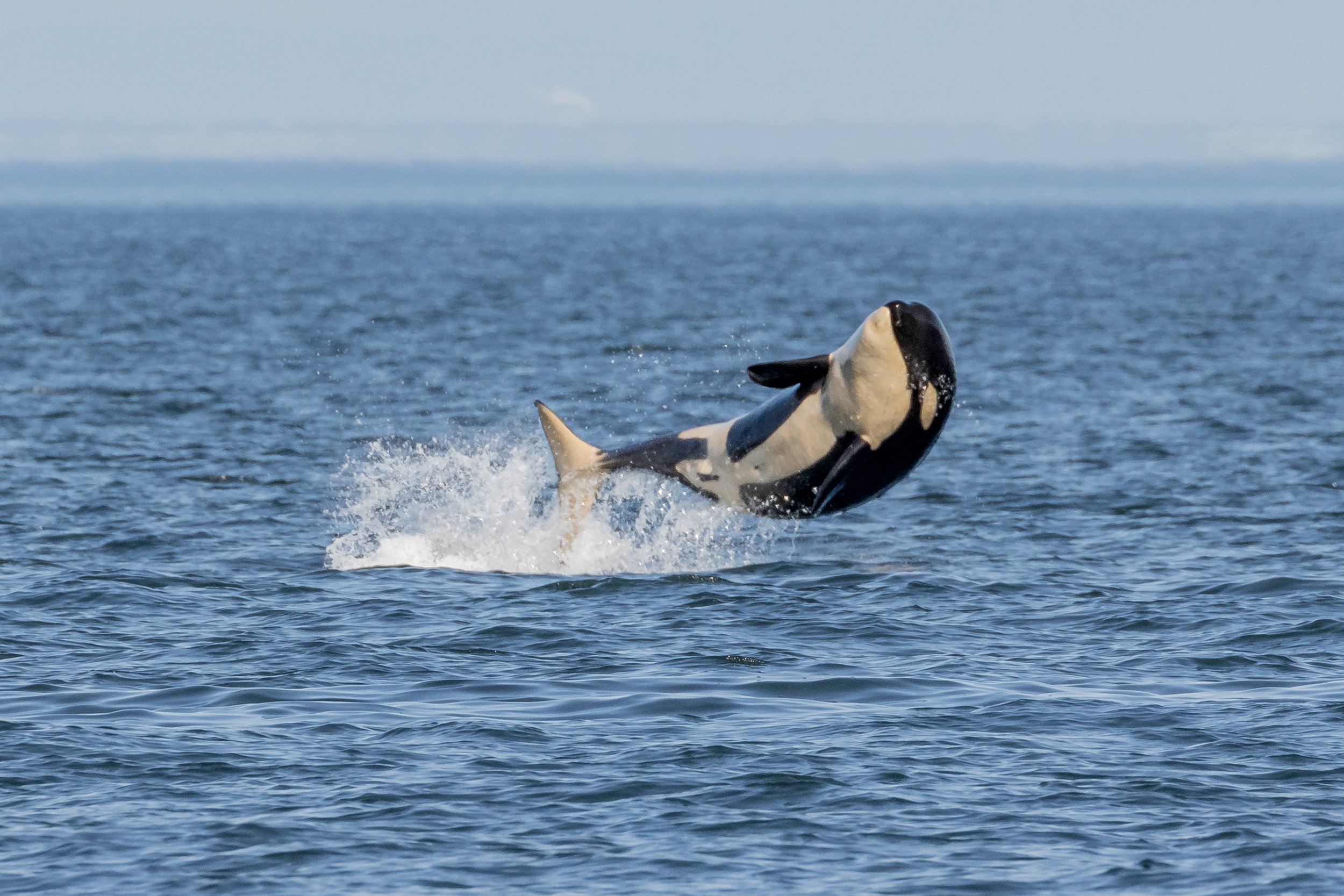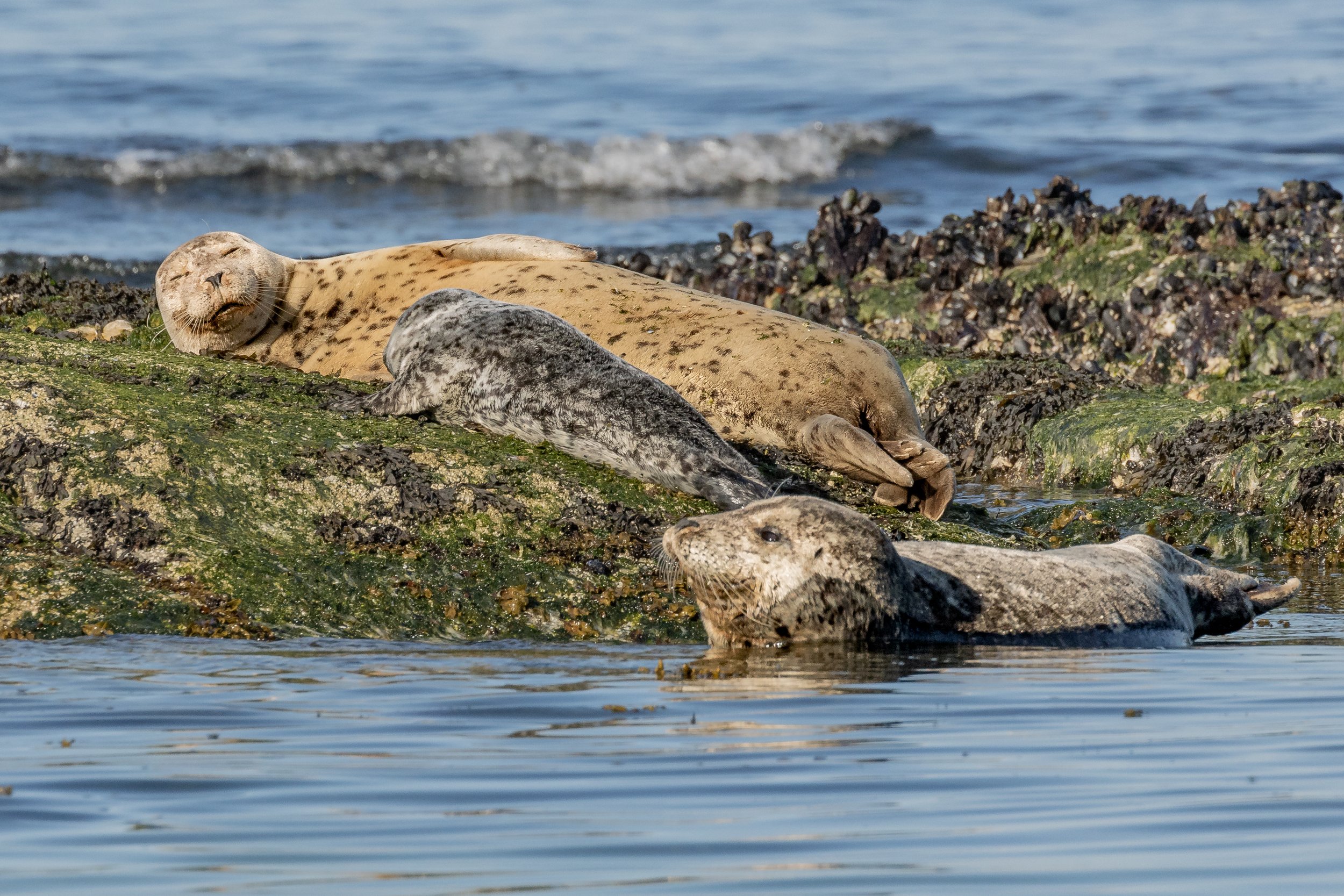July 9, 2023, 3:30 PM - The T065Bs celebrating after a hunt!
This afternoon’s tour was filled with a celebration! A successful hunt from the T065Bs, which includes the following individual transient orcas:
T065B Chunk ♀ (1993)
T065B1 Birdsall ♂ (2011)
T065B2 Nettle ♂ (2019)
T065B3 (2023)
The T065Bs are an easy pod to identify. T065B Chunk has a very distinct chunk out of her dorsal fin, hence her given name “Chunk”. T065B Chunk is one of four matriarchs this year (so far) to have a new baby following along by her side. When babies are as new as hers, they are very orange in appearance, whereas they would normally be white if they were an adult. The reason for the orange appearance of new orca calves is that they aren’t born with a thick layer of blubber around their bodies, so their blood vessels are much closer to the outer surface of their bodies, creating a more orange/pink appearance of the orca’s white colouration. It sure makes for some lovely little orange face photos!
T065B1 Birdsall, who is Chunk’s oldest child has started his growth spurt. At around the age of 8-12 years, male orcas will begin their puberty and have a huge growth period, in which their dorsal fins grow tremendously, reaching up to 6 feet or 1.8 meters tall by the time they are 20-25 years old. This makes them very distinct from a distance and great for sighting, as the larger dorsal fins are easier to spot on wavy days out in the Strait of Georgia.
Also spotted on today’s tours were harbour seals, galumphing (moving clumsily) along the rocks. Harbour seals are transient orcas most preyed upon snacks. Each orca needs to eat about 300 lbs of food each day. An adult harbour seal weighs about 285 lbs when fully grown and orcas pick and choose which parts of their food they want to eat. Generally, the blubber is the main course of a harbour seal meal for transient orcas. Transients also feed on harbour porpoises, sea lions and even baby humpback and grey whales. Orcas work as a team to take down their prey and once it is caught, they will grasp onto the animal from either side and tear it apart into chunks and swallow it whole. They tear apart their food, but orcas do not chew it.
It was a great day spent with the T065Bs and all the other wildlife, and our naturalist Aly Kohlman captured some amazing photos of the day which can be viewed below!
Likely Birdsall doing a tail slap!
Nettle Spy Hopping!
A fluke out of the water and a young whale surfacing next to it.
Nettle surfacing beside another member of the T065Bs.
Birdsall Tail Slapping.
Birdsall’s dorsal fin. It’s in the process of Sprouting!
The underside of the new baby’s (T065B3’s) belly! Notice the orange colouration?
Another Spy hop!
T065B3 breaching!
T065B3 breaching!
T065B3 coming in for a touchdown.
Nettle sticking his face out of the water.
Tail wave from one of the T065Bs.
Flicking of the tail!
Look at all the water it sends flying with all the force!
About to do another tail flick!
Nettle surfacing and showing off his eye patch.
A larger male Steller Sea Lion amongst the smaller females and younger males.
A fight breaks out amongst the sea lions.
Let the yelling commence.
A Steller Sea Lion posing on Stinky Rock.
Another poser! This time a Harbour Seal.
Look at the little seal pup! SO cute!
The seal pup amongst the Fucus.
Look at the size difference!
A very sleepy harbour Seal.
Pinecone and Freddy in their nest.
Pinecone amongst his name sakes.
One of the Adult Bald Eagles keeping an eye on things.
A very happy Pigeon Guillemot.
Takeoff!
A cormorant in the water.
The cormorants are also getting ready to fledge.
Check out the iridescence on the adults.


































